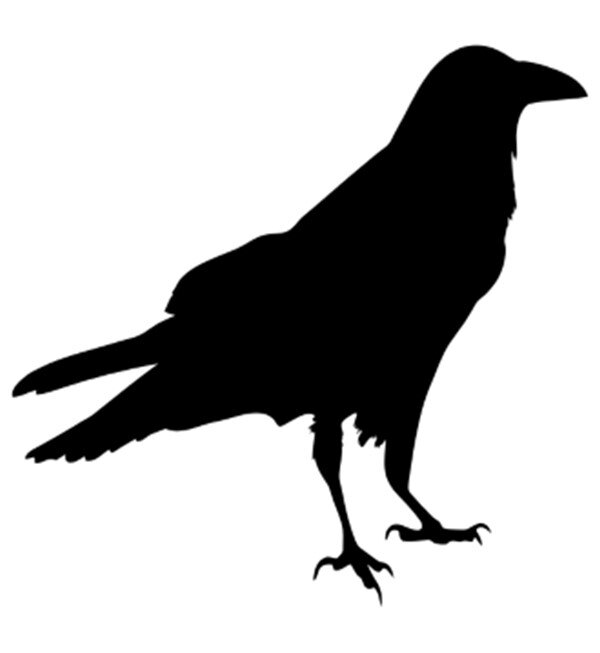A familiar sight, especially this time of year. Large black birds in fields, in trees, picking at road kill on the highway, watching us from the rooftops. Sometimes solitary, sometimes in large noisy gangs. Like a few other creatures in our forest at Silver Falls, these black birds have the unfortunate reputation of being associated with omens, death, and all things creepy. We even refer to a group of crows as a “murder”! Or do we? More on that later.
Let’s take a moment, however, to separate the science from the cultural depictions and hopefully in the process, inspire admiration for this family of rather remarkable birds!
A Case of Mistaken Identity
A common mistake is confusing a raven from a crow. They are indeed two different species, although both are in the Corvidae family along with Steller’s jays, grey jays, and magpies. Both the raven and the crow are completely black, down to their beaks, feet, and even eyeballs. However, a few key differences can be helpful in identifying which is which.
American Crow
Corvus brachyrhynchos
Common Raven
Corvus corax
Size:
Ravens are much larger than crows. They are roughly the size of a red-tailed hawk. Interestingly, 97% of conflict between ravens and crows is instigated by crows. Though smaller, crows will use mob tactics to harass the larger ravens.
Silhouette:
Raven’s beaks are large and curvy in comparison to a crow’s.
Raven’s neck feathers, called hackles, are shaggier. Neck feathers are an excellent communication tool! Fluffed hackles display social dominance.
Rictal bristles (basically the avian version of the mustache) extend half way down the raven’s beak. Crows have rictal bristles as well, but they are considerably shorter. Scientists think these whiskers aid the bird in navigation, foraging, and in avoiding collisions. No studies indicate anything about a possible Tom Selleck effect with the lady ravens!
In Flight:
The middle tail feathers on a raven are longer that the others, creating a wedge-shape in flight. The even lengths on a crow’s tail feathers make a fan-shape. (see photos below)
The raven is an acrobatic flier, soaring and doing spins and somersaults. When they do flap, their wings make swooshing sounds in contrast to the relatively quieter wing flaps of the crow.
Which is the raven and which is the crow in the photos below?
Photo credit: Joe Bartok (CC by NC)
Photo credit: Edward Rooks (CC by NC)
Social Behavior:
Ravens are mostly seen solitary or in pairs. They are not a social bird, unlike their crow cousins.
Vocalizations include croaks and screams in contrast with the caw and purr of the crow.
Ravens are not as likely to be seen in urban areas, whereas crows have thrived from urbanization.
Crows have a very complex social structure. Unlike most bird species, juveniles are not booted from the nest but will remain with their parents for years to come. Family groups can be up to 15 members and occasionally include “adopted” juveniles.
In the fall, gangs of new fledglings and yearlings will gather and baby crows may be heard practicing vocalizations.
“The Compaynys of Beestys and Fowlys”, The Book of Albans, 1486
Collective Nouns: a matter of opinion:
There are many names that refer to groups of animals:
A pod of whales
A parliament of owls
A gaggle of geese
Crows have been given the unfortunate moniker of a “murder of crows”, likely at least partly due to their widespread association with death. They are, after all, carrion birds.
As it turns out, biologists and the scientific community largely do not subscribe to this system of names. A little digging reveals the origins of collective nouns to be from 15th century hunting terminology as described in The Book of Saint Albans, 1486. The intent was to efficiently describe “Fowlys and Beestys” and an assortment of other groups (princes, wives, doctors for example) but now, over 500 years later, many consider these terms charming and entertaining, while others claim them to be “antiquated and absurd”. The decision is your to make.
The Einsteins of the Bird Community:
Corvids as a group are among the most intelligent species on the planet. There are numerous studies of these fascinating birds that have revealed cognitive abilities that go far beyond those of most all other creatures. Notably, these birds are curious an playful and exhibit flexible behavior that extends beyond instinctual responses.
Nature may have cleverly equipped those woodpeckers with long, barbed tongues to snatch those juicy grubs out of the hole in the tree but gave the corvids problem-solving brains instead. The result: crows are commonly known to fashion hooks out of twigs or wire to extract insects from inside a tree!
Amazingly, ravens and crows have facial recognition. Not only that, but they also recognize individuals as “friend” or “threat”. Your neighborhood crows know who you are, who your neighbors are, who is naughty and who is nice! A well-known study in Seattle illustrates the extent to which crows learn and remember:
Photo credit: Phyllis Pietz; Silver Falls State Park
Students with full face masks trapped, banded, and later released several crows around campus. The crows were not injured but an unpleasant and frightening experience for the crows all the same. Grudges were held. When those same students later returned without masks or with different masks, they were ignored by the crows. However, anyone wearing the same masks as the trappers were harassed and dive-bombed by gangs of crows - even by crows that had not been trapped!
“Teach your children well” is apparently the crow motto. Ten years after the trapping incident, after the original trapped crows have died, subsequent generations of the crows of University of Seattle have been taught to recognize and remember “that villain". Anyone wearing that particular mask continues to be mobbed and harassed.
To emphasize that the achievement here is not about holding grudges but about the extraordinary learning, memory, and ability to pass memories on to future generations, studies also show the recognition of kind individuals. Helpful people and those who show kindness or offer treats to crows are frequently brought gifts. If a shiny object shows up on your roof or in your yard, chances are you’ve been marked as one of the good guys by your local gang of crows!
Sources and for additional information:
Gifts of the Crow: How Perception, Emotion, and Thought Allow Smart Birds to Behave Like Humans; Marzluff, John and Angell, Tony, 2012
https://www.allaboutbirds.org/guide/Common_Raven/
https://www.audubon.org/magazine/march-april-2016/meet-bird-brainiacs-american-crow (Kat McGowan author)
BBC article: Crows could be the smartest animal other than primates By Chris Baraniuk 11th December 2019
https://onlinelibrary.wiley.com/ Anatomy of avian rictal bristles in Caprimulgiformes reveals reduced tactile function in open-habitat, partially diurnal foraging species; March 23, 2020






















